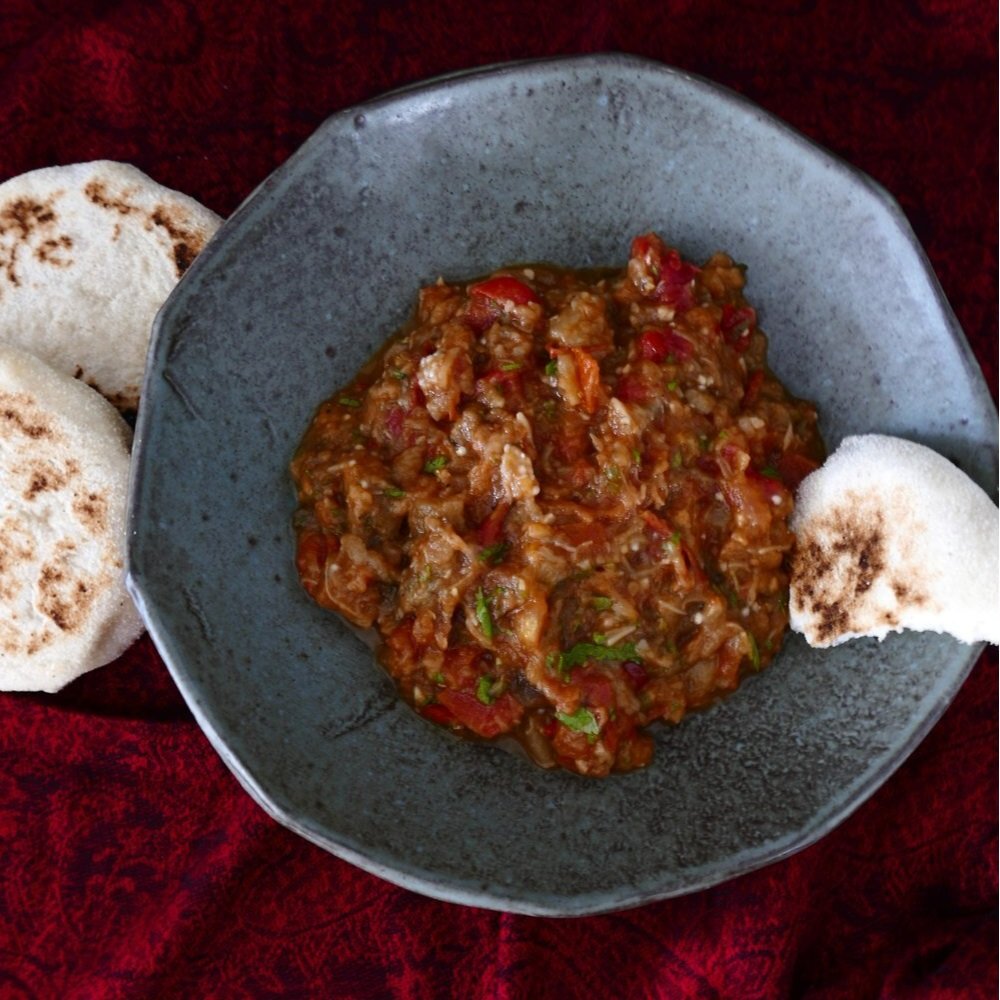The Recipe
Serves: 3-4 people
Preparation: 10 minutes
Cooking Time: 10-15 minutes
Zalouk is believed to have originated in North Africa, where eggplant and tomatoes are commonly grown. It is thought to have been influenced by the neighboring cuisines of the Mediterranean and the Middle East.
Eggplants are probably one of my favourite vegetables (actually it is a fruit). Thai eggplants, brinjal, aubergine, baby eggplants are so versatile to make salads, dips, curries, stews and this super easy tomato and eggplant salad.
This Moroccan salad is one of my favourite dishes and can be made a few days in advance. Just sit it at room temperature, dress with a bit of oil, lemon and a good side of batbout bread. Batbout is great as it is cooked on the stove so no oven is needed for this recipe! Batbout is even good with butter and honey – it’s reminiscent to and English Muffin of sorts.
THE INGREDIENTS
Zalouk
600g eggplant (1 medium size)
400g really ripe fresh tomatoes, roughly chopped, seeds and skin removed
2-3 cloves of garlic, finely chopped
1 tsp cumin seeds, toasted
1 tsp paprika
½ tsp cumin
½ lemon
1 tsp honey
2 tblsp good olive oil
Chopped flat leaf parsley
Lemon juice and salt to taste
Garnish
Chopped parsley and lemon wedge
THE METHOD
Cook the eggplant over an open fire until the skin is nice and black. You also can use a grill in the oven. Place in a plastic bag and allow it to sweat it out for a bit then peel the skin. Roughly chop and set aside
Lightly fry the garlic and the tomatoes with oil on medium heat.
Add the spices to the tomato as well as honey and eggplant. Cook through for about 10-15 minutes and season with salt and lemon juice. Allow to cool before throwing in parsley leaves.
Eat at room temperature, garnish with extra parsley, olive oil and lemon wedge.
THE RECIPE – BATBOUT
Makes 6 pieces
Preparation time: 15 minutes plus proving time
Cook time: 5 minutes each
THE METHODMix the yeast with sugar and 2 tblsp warm water
Combine the flours and salt in a separate bowl
Add the oil and water to the yeast mixture
Place in an electric mixer with dough hook attachment and mix until combined and smooth
Roll and smooth out. Place in an oiled bowl, cover with cling film and allow to double in size
Turn out the dough and divide into even balls, flatten slightly and roll them in extra semolina
Heat a cast iron fry pan and cook the bread (about a minute each side), or until golden and cooked through
Serve with the delicious salad above
BABOUT
Makes: 6 pcs - Preparation Time: 15 minutes - Cooking Time: 5 minutes each
THE INGREDIENTS
1.5 tsp instant yeast
1 tsp caster sugar
150g plain flour
100g semolina
120-150mls water
1 tblsp olive oil
THE METHOD
Mix the yeast with sugar and 2 tblsp warm water
Combine the flours and salt in a separate bowl
Add the oil and water to the yeast mixture
Place in an electric mixer with the dough hook attachment and mix until combined and smooth.
Roll and smooth out. Place in an oiled bowl, cover with cling film, and allow to double in size
Turn out the dough and divide it into even balls, flatten slightly, and roll them in extra semolina.
Heat a cast iron fry pan and cook the bread (about a minute on each side), or until golden and cooked through.
Serve with the delicious salad above.






